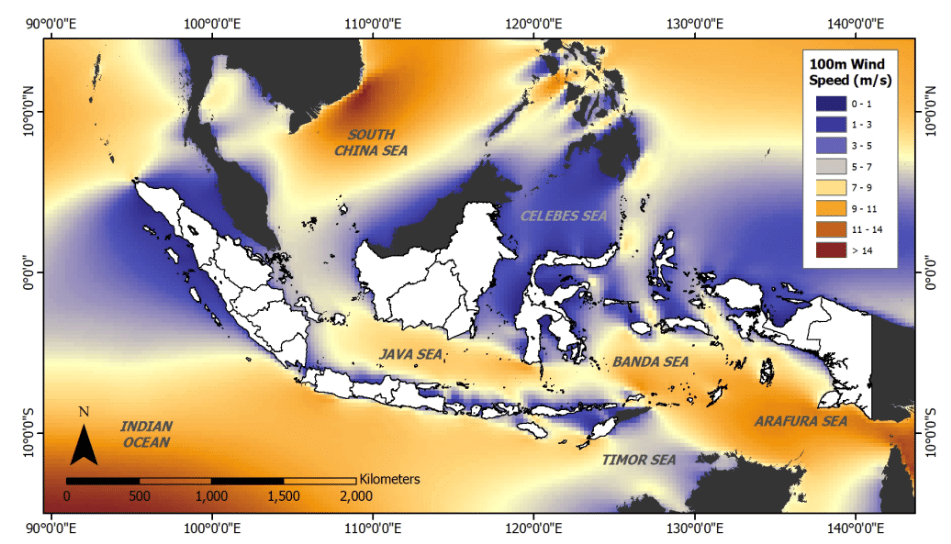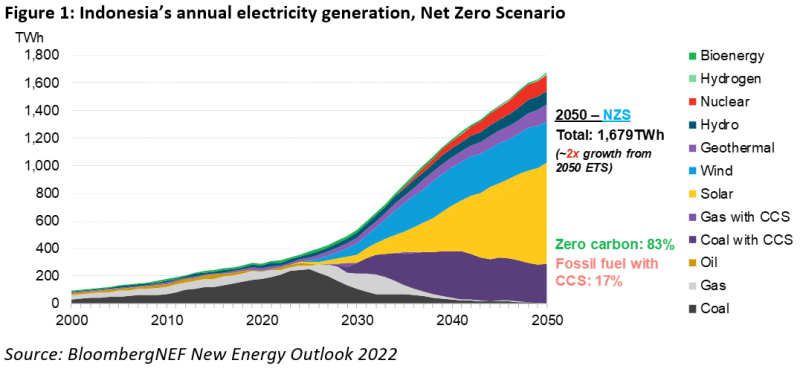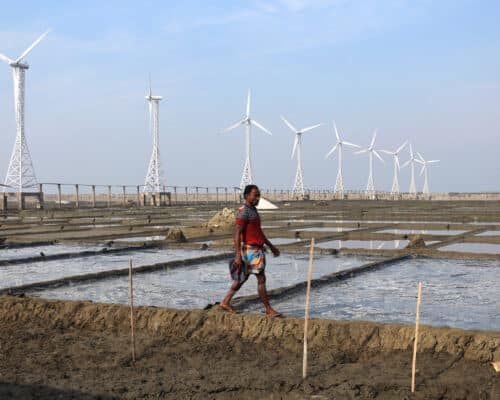Wind Energy In Indonesia: Slow Growth, Promising Future
Source: Lowy Institute
22 February 2024 – by Eric Koons
Indonesia’s strategic position across the equator not only gives it significant potential for solar energy but also positions it as a candidate for wind energy development. Despite the nascent stage of its wind energy sector, Indonesia has set ambitious goals to transform its energy landscape. The country is aiming to increase its renewable energy generation share to 44% by 2030 and have net-zero emissions by 2060.
Solar power, hydropower and wind energy will be the renewable energy production technologies leading this transition. However, the contribution of wind energy in Indonesia to the national grid remains minimal, underscoring a significant gap between potential and actualisation.
Is Wind Energy Used in Indonesia?
Wind energy development in Indonesia has been slow, with only 154 MW of installed capacity as of 2022. This has remained relatively unchanged since 2018 and accounts for less than 0.15% of the country’s electricity production.

Despite having a theoretical capacity to generate substantial amounts of wind power in Indonesia, particularly in the eastern regions where wind speeds are favourable, development has been hampered by several factors. These include infrastructural limitations, regulatory hurdles and the need for substantial initial investment in wind facilities. The development of wind energy projects is also hindered by the archipelago’s complex topography and the variable nature of wind speeds across different regions, making site selection and project execution challenging.
Indonesia’s Wind Energy Potential
Indonesia’s wind energy potential is estimated at 9.5 GW. While many parts of the country have low average wind speeds, making them unsuitable for wind power, other regions have much stronger winds.
The average wind speed in Indonesia ranges from 1.3-6.3 m/s, with East and West Nusa Tenggara and southern Sulawesi on the higher end of the spectrum. These areas are above the threshold for viable wind power generation and are considered to have the highest potential for wind energy generation.
Furthermore, when offshore winds are considered, Aceh, Southern Java and Southern Papua are viable options. In each location, over 80% of the area meets the minimum threshold for offshore wind power.

Major Wind Energy Projects in Indonesia
Existing Onshore Wind Farms
Indonesia’s two largest and only utility-scale wind farms are in southern Sulawesi. The largest is the Sidrap Wind Farm, which came online in 2018 and consists of 30 wind turbines on a group of windy ridges. It currently has an installed capacity of 75 MW, which can power over 70,000 homes.
The Tolo Wind Power Plant is the second largest, with an installed capacity of 72 MW. The facility also started operations in late 2018 and consists of 20 turbines. While owned by an independent power company, it ties directly into the local energy grid and sells its energy to the state-owned power utility.
Future Onshore Wind Power Development
Looking ahead, Indonesia has several ambitious projects underway to expand its wind energy capacity.
Leading the way is the Jakarta Wind Power Plant. It’s an onshore facility that will have a capacity of 597 MW, making it the largest by a significant margin. The project is being built by the state-owned electricity company PT PLN.
The next largest wind facility in the pipeline is the Sukabumi Wind Farm. The facility is located in West Java and will have a capacity of 258 MW. While expected to come online in 2025, it is still in the permitting stage.
These future projects are much more extensive facilities than already exist and will significantly contribute to Indonesia’s renewable energy goals.
Overcoming Barriers to Wind Energy Expansion
In charting the path forward for wind energy in Indonesia, there are significant challenges but also vast opportunities that promise to reshape the country’s energy landscape and achieve net zero emissions. This is particularly true for offshore wind, which will contribute to over 60% of the country’s installed wind energy capacity in several of its net-zero scenarios. However, offshore wind remains largely untapped, indicating the need for technological innovation and international partnerships to exploit these resources effectively.

To overcome these challenges, Indonesia is starting to make progress in attracting investment and fostering collaborations to bolster the wind energy sector. However, it needs to consider other, more far-reaching policies that incentivise both domestic and international renewable energy development.
Wind energy growth in Indonesia requires a concerted effort from government bodies, private sector stakeholders and international partners. By addressing the challenges of infrastructure, investment and regulation, Indonesia can harness its significant potential for wind energy. Without this effort, Indonesia will struggle to meet its renewable energy targets and global decarbonisation commitments.
by Eric Koons
Eric is a passionate environmental advocate that believes renewable energy is a key piece in meeting the world’s growing energy demands. He received an environmental science degree from the University of California and has worked to promote environmentally and socially sustainable practices since. Eric’s expertise extends across the environmental field, yet he maintains a strong focus on renewable energy. His work has been featured by leading environmental organizations, such as World Resources Institute and Hitachi ABB Power Grids.
Read more







